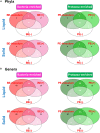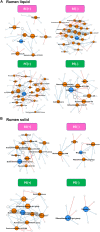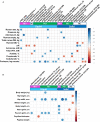Pre-weaning Ruminal Administration of Differentially-Enriched, Rumen-Derived Inocula Shaped Rumen Bacterial Communities and Co-occurrence Networks of Post-weaned Dairy Calves
- PMID: 33717013
- PMCID: PMC7952535
- DOI: 10.3389/fmicb.2021.625488
Pre-weaning Ruminal Administration of Differentially-Enriched, Rumen-Derived Inocula Shaped Rumen Bacterial Communities and Co-occurrence Networks of Post-weaned Dairy Calves
Abstract
Adult rumen fluid inoculations have been considered to facilitate the establishment of rumen microbiota of pre-weaned dairy calves. However, the sustained effects of the inoculations remain to be explored. In our previous study, 20 pre-weaned dairy calves had been dosed with four types of adult rumen inoculums [autoclaved rumen fluid, bacterial-enriched rumen fluid (BE), protozoal-enriched (PE), and BE + PE] weekly at 3 to 6 weeks of age. To verify the sustained effect of adult rumen inoculation, the rumen bacterial communities, fermentation characteristics, and animal performance measurements were measured after sacrifice from 20 post-weaned dairy bull calves (9 weeks of age). Ruminal pH tended to be lower in BE treated calves (n = 10). All PE treated calves had rumen ciliates (>104 cells per ml of rumen fluid). PE treated calves had greater VFA concentrations (P = 0.052), lower molar proportions of isobutyrate (P = 0.073), and butyrate (P = 0.019) compared to those of control calves. No treatment differences were found in all animal performance measurements. Both PE and BE inocula increased bacterial species richness, Faith's phylogenetic diversity, and Shannon's index in rumen liquid fractions. However, the relative proportion of those bacterial taxa possibly transferred from the donor's rumen was minor. Microbial network analysis showed different co-occurrence and mutually exclusive interactions between treatments of microbial inoculations. Collectively, adult rumen inoculations in pre-weaned dairy calves slightly altered the rumen bacteriome of post-weaned calves without changing fermentation and animal performance.
Keywords: adult rumen inoculation; dairy calves; microbial network; protozoa; rumen bacterial communities.
Copyright © 2021 Park, Cersosimo, Li, Radloff and Zanton.
Conflict of interest statement
The authors declare that the research was conducted in the absence of any commercial or financial relationships that could be construed as a potential conflict of interest.
Figures





Similar articles
-
Microbial inoculum effects on the rumen epithelial transcriptome and rumen epimural metatranscriptome in calves.Sci Rep. 2024 Jul 23;14(1):16914. doi: 10.1038/s41598-024-65685-y. Sci Rep. 2024. PMID: 39043743 Free PMC article.
-
The rumen liquid metatranscriptome of post-weaned dairy calves differed by pre-weaning ruminal administration of differentially-enriched, rumen-derived inocula.Anim Microbiome. 2022 Jan 5;4(1):4. doi: 10.1186/s42523-021-00142-z. Anim Microbiome. 2022. PMID: 34983694 Free PMC article.
-
Microbial Inoculum Composition and Pre-weaned Dairy Calf Age Alter the Developing Rumen Microbial Environment.Front Microbiol. 2019 Jul 23;10:1651. doi: 10.3389/fmicb.2019.01651. eCollection 2019. Front Microbiol. 2019. PMID: 31396179 Free PMC article.
-
Effects of isobutyrate supplementation in pre- and post-weaned dairy calves diet on growth performance, rumen development, blood metabolites and hormone secretion.Animal. 2017 May;11(5):794-801. doi: 10.1017/S1751731116002093. Epub 2016 Nov 8. Animal. 2017. PMID: 27821226
-
Effects of supplemental butyrate and weaning on rumen fermentation in Holstein calves.J Dairy Sci. 2019 Oct;102(10):8874-8882. doi: 10.3168/jds.2019-16652. Epub 2019 Jul 24. J Dairy Sci. 2019. PMID: 31351719
Cited by
-
- Invited Review - Ruminal ciliates as modulators of the rumen microbiome.Anim Biosci. 2024 Feb;37(2):385-395. doi: 10.5713/ab.23.0309. Epub 2023 Dec 29. Anim Biosci. 2024. PMID: 38186255 Free PMC article.
-
Microbial inoculum effects on the rumen epithelial transcriptome and rumen epimural metatranscriptome in calves.Sci Rep. 2024 Jul 23;14(1):16914. doi: 10.1038/s41598-024-65685-y. Sci Rep. 2024. PMID: 39043743 Free PMC article.
-
Red seaweed extracts reduce methane production by altering rumen fermentation and microbial composition in vitro.Front Vet Sci. 2022 Nov 16;9:985824. doi: 10.3389/fvets.2022.985824. eCollection 2022. Front Vet Sci. 2022. PMID: 36467635 Free PMC article.
-
Liver microbial community and associated host transcriptome in calves with feed induced acidosis.Front Vet Sci. 2023 Oct 23;10:1193473. doi: 10.3389/fvets.2023.1193473. eCollection 2023. Front Vet Sci. 2023. PMID: 37941815 Free PMC article.
-
Long-term effects of early-life rumen microbiota modulation on dairy cow production performance and methane emissions.Front Microbiol. 2022 Nov 8;13:983823. doi: 10.3389/fmicb.2022.983823. eCollection 2022. Front Microbiol. 2022. PMID: 36425044 Free PMC article.
References
-
- Bastian M., Heymann S., Jacomy M. (2009). “Gephi: an open source software for exploring and manipulating networks,” in Proceedings of the Third International Aaai Conference on Weblogs and Social Media, San Jose, CA.
LinkOut - more resources
Full Text Sources
Other Literature Sources

